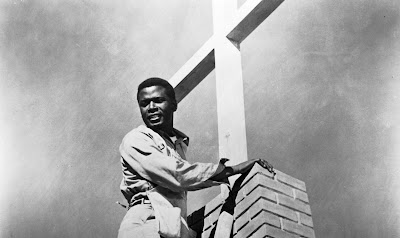 |
| Images courtesy of United Artists |
Emmy-award winning television director Ralph Nelson best
known at the time for directing both the 1956 Playhouse 90 teleplay and
the 1962 feature film version of Rod Serling’s boxing drama Requiem for a
Heavyweight maintained steady work in television until 1963 when he began
more extensive feature film directing. Drawing
from his economic television experience and working in as many as two pictures
per year between 1963 and 1970, the prolific microbudget filmmaker not needing heavy
means to make a picture worked quickly yet effectively as he swept numerous
film festival awards circuits with his extensive yet quickly rendered
oeuvre. Ultimately Nelson who also
served as a part-time character actor would generate two films in 1963: the
Jackie Gleason/Steve McQueen buddy comedy Soldier in the Rain and the Oscar
winning Sidney Poitier starring dramedy Lilies of the Field.
Based on William Edmund Barrett’s 1962 of the same name
which was partially based on the author’s own experiences with the Benedictine
nuns of the Abbey of St. Walburga in Colorado, it tells the story of black handyman
Homer Smith (Sidney Poitier) who is drifting through an Arizona desert when he
makes a pit stop at an isolated farm looking for water for his car. There he meets a group of nuns who have
emigrated from former East Germany, spearheaded by the headstrong Mother Maria
Marthe (Austrian architect Lilia Skala in a semi-autobiographical role) who are
wanting to build a chapel for the Mexican American population nearby. Initially reticent to commit to the task as
Mother Maria refuses payment after quoting the Bible’s Sermon on the Mount,
Smith eventually meets with a local café manager named Juan (Stanley Adams) and
agrees to construct the chapel after learning of Mother Maria and the sisters’
escape from the Nazis. As he offers free
English lessons at the dinner table and tries to form camaraderie with the Mexican
populace, Smith finds himself clashing with Mother Maria’s stern worker-bee
outlook on life, threatening to jeopardize completion of the chapel.
Heartwarming, charming and straightforward, Lilies of the
Field is very much an actor’s film largely resting on the shoulders of
Sidney Poitier who imbues the character of Homer Smith with a larger-than-life
presence. Almost leaping off of the screen
spectacularly with energized and wholly confident delivery, it came well into
the actor’s filmography following Blackboard Jungle and The Defiant
Ones. While the dramatic conflict of
the story itself is somewhat lighthearted if not playfully whimsical, what is
hinted at regarding the German nuns’ wartime experiences lands heavily. Almost equaling Poitier’s prowess is Lilia Skala
as the determined and stern Mother Maria who shows no fear of backing down from
Poitier as he tries to lay down the law of how he should be compensated for his
time. Stanley Adams as the Mexican
bartender, having started out playing that role in Death of a Salesman
before moving onto Ralph Nelson’s adaptations of Requiem for a Heavyweight,
is a comforting presence and serves up comic relief opposite Poitier when they
start dueling over whether or not he’ll accept outside help building the
chapel.
Reportedly shot within fourteen days in Arizona largely on a
ranch owned by Linda Ronstadt’s family by multiple Academy Award nominated
cinematographer Ernest Haller with a very early score by Jerry Goldsmith, the
$247,000 quickie wound up becoming a critical and commercial favorite out of
the gate. Grossing around $7 million and
garnering five Oscar nominations including Best Picture, it ultimately won
Poitier the Best Actor award. Further
still, the film’s gospel hymn ‘Amen’ sung by Poitier’s character albeit dubbed
over later by Jester Hairston (who also wrote the song) became increasingly
popular in the years since the film’s release.
Though Poitier would express reservations about the role before and
after the film’s Oscar win, it nevertheless canonized the actor as a true
American original in a film that plays beautifully to his strengths and in a
way started paving room for what would or wouldn’t develop years later into the
New Hollywood movement.
--Andrew Kotwicki




